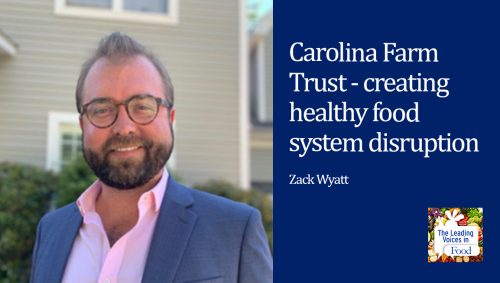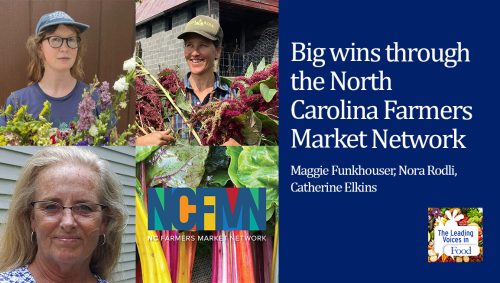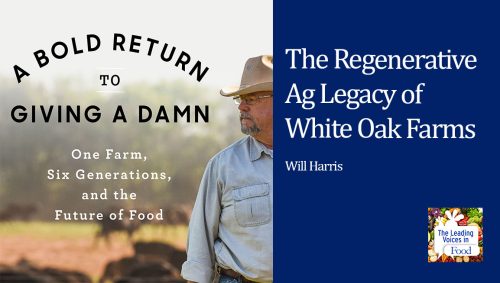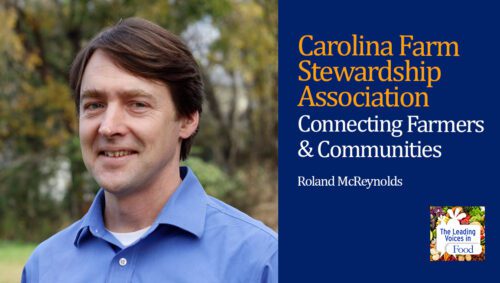The Leading Voices in Food
E153: The Farmer’s Language of Climate Change and Land Regeneration
Today, we’re talking with ecologist, Steven Apfelbaum, author of “Nature’s Second Chance”, a book that was named a top 10 environmental book in 2009, and was one of the top 10 books for understanding what you can do about climate change. So Steve is going to talk about his work to improve soil health, a really amazingly interesting and important topic, but also how grazing and how farming can be improved, and how to restore land using nature’s own processes. He’ll also speak about how such work minimizes climate impact, while also reducing flooding, increasing food quality and nutrition, and improving land health. Steven Apfelbaum is a senior ecologist and science advisor at RES, Resource Environmental Solutions, and Founder and Chairman of Applied Ecological Services. This podcast is part of our Regenerative Agriculture series.
Subscribe: Apple Podcasts | TuneIN | Google Podcasts | SoundCloud | PocketCasts | Radio Public
Tags: Agriculture & Tech | Regenerative Agriculture | Voice of Farming |

Steven I. Apfelbaum is Chair of Applied Ecological Services, Inc., one of the larger ecological-sciences and restoration firms in the United States. He is also a Senior Ecologist and Science Advisor at RES. He is co-author of Restoring Ecological Health to Your Land (Island Press), written to help landowners and land stewards—including agency staff managing state, federal, and other public lands—successfully develop and implement land-restoration programs. Apfelbaum’s book Nature’s Second Chance (Beacon Press) won awards as one of the “top ten environmental books of 2009” and one of the “top 10 books for understanding what you can do about climate change.” Steven Apfelbaum has conducted ecological research, designed award winning projects, successfully navigated regulatory programs, and contributed his unique creative scientific expertise and enthusiasm to over 7,000 projects throughout North America and beyond. He is one of the leading ecological consultants in the U.S., providing technical restoration advice and win-win solutions where ecological and land-development conflicts arise. He has authored hundreds of technical studies, peer reviewed technical papers, books, reports, ecological restoration plans, and regulatory monitoring and compliance reports. Steve’s book, Nature’s Second Chance (Beacon Press), won accolades from the New York Times, and was listed as one of the “Top 10 Environmental Books of 2009.” Restoring Ecological Health to Your Land (Island Press), his most recent book (coauthored with Alan Haney and part of a three-volume series), has won praise as the first comprehensive ‘how-to’ restoration books for landowners. He promotes using ecological and conservation design principles in developments, industrial projects and parks that help clients save money while increasing ecological functionality, improving public perception and generating award-winning outcomes.
Interview Summary
So there’s lots of talk these days about food and environment. Perhaps not enough still, but certainly more than what used to be the case, and it would help to have some context. So, do you think food systems changes can really help reduce climate risks, and if so, kind of how much? Give us some context for this.
Great question, Kelly, and a very interesting question, because it’s not really clear to most people how significant the land base is that we alter currently and what we’ve managed over time. There’s about 5.5 billion hectares of land, 3.5 billion in grazed landscapes, and about 2-2.5 billion hectares on the planet that we manage in row crops, in rough numbers. And that is out of about 14 billion hectares of terrestrial land on the planet. It turns out that approximately 43% of the excessive atmospheric greenhouse gases now in the atmosphere are derived from the collapse of soil systems. They’re emissions released as organic matter in soil that’s deteriorated by tillage and caustic fertilizer use, and through the erosion and decomposition of soils. The greenhouse gases that have come out of the disruption of soil systems include carbon dioxide, methane, nitrous oxide, and others. Currently around 14% of the greenhouse gas emissions result from these same causes. When you factor in externalities like the mining and manufacturing of fertilizers, the emissions are actually higher than 14% currently. So, historically and currently, Ag plays a very, very huge role in greenhouse gas emissions. And therefore, as we’ll talk about in a minute here, a very big role in solving the excessive greenhouse gas emissions that are currently in the atmosphere, and those that will be.
So, improved grazing and improved cropping are two strategies. You know grazing can be implemented on some or all of the 3.5 billion hectares of range land, and the improved cropping on the 2-2.5 billion hectares of farmland on the planet. And what we’ve learned through research on improved grazing, especially adaptive multi-paddock grazing, which is very high density, long recovery grazing, is consistently in the range of three to five tons of CO2 per hectare per year improvements over and across the fence where conventional grazing may be occurring. So if you multiply 3.5 billion hectares of grazed land on earth, by just one ton of CO2 per hectare per year, that’s around 3.5 gigatons, or 3.5 billion tons of CO2 that we should be able to pull down from the atmosphere and put back into the soil. And when you add improved cropping – such as low disturbance cropping, one pass no-till, and a range of other practices, you know, cover cropping, crop perennialization, eliminate a range of fertilizers served besides irrigation, significantly reduce or eliminate soil tillage – what we’ve measured where those changes have occurred is upward of two tons of CO2 equivalent per hectare per year being achievable. And when you add that together with the improved grazing potential, the answer is a very loud yes, that agriculture can be, should be, and is probably the only scalable, rapidly economically-viable solution to some of the climate change issues that we’re facing.
Those are impressive numbers. So you’re really talking about addressing climate through agriculture in two ways. One is you can stop some of the destructive things that are going on now, but you can actually help reverse the destructive nature of climate change by changing practices and drawing down carbon from the atmosphere, and using the soil as a way to reverse damage that’s already done. Is that correct?
Exactly. If you view the soil as a large storage battery, where what it stores, among other things, is soil carbon and soil carbon is most readily stored below ground, out of harms’ way from wildfires that trees and above-ground biomass are subjected to or vulnerable to, it’s surprising even with poor farming management practices, how soil organic matter, soil carbon, continues replenishing. It replenishes at a slower rate, and therefore less of it becomes produced annually, but soil microbes and bacteria, fungi, and plant root dieback on an annual basis draws soil carbon from the bottom-up. And it is an important way that the earth has stored carbon since the earth began getting in the carbon business.
Well, let me ask a question about farmers, and how in general, farmers, and I know you can’t generalize across all of them, but how much attention are farmers paying to this issue? And the one the reason I ask that is I was actually at a breakfast meeting this morning with Duke colleagues. One of them said that the term climate change is radioactive to many farmers, and they turn off to it and don’t want to engage in the conversation. But if you mentioned weather changes, then they’ll be very responsive because they kind of witness the impact of this in their day-to-day lives. So, certainly there are a group of regenerative Ag farmers who were very keen on this, and of course speak the same language that you’re using, but what about farmers in general? Is this something that’s of concern to them, what do they think about the future, and climate, and what do you think the picture is with that?
Well, I think the picture is coming into crystal view at different rates in different parts of the country, different parts of the world. And it largely depends on the availability of moisture to grow crops. Where farmers are experiencing a reduced availability or reliability of moisture and growing conditions for their crops, they’re listening attentively to what’s happening. Our language matters. One of the things that we’ve learned consistently is that every farmer believes that soil health and good rolling conditions are critical to their farming operations. And every farmer also realizes the importance of the appropriate meteorological conditions, weather conditions, such as you brought up, Kelly, to support the farming production that their life and livelihood depends on. So the language that is most easily understood, most easily communicated, and it’s what’s communicated within the farming circles rather than external language that’s brought to that circle, is the language of weather, is the language of how are my crops doing, how are your crops doing? It happens at every coffee house, every coffee shop, every restaurant diner in rural America, probably every single day during the growing season. And then they talk about it the rest of the year during the winter about what it did or didn’t do during the year. So, farmers are very focused on the economics of their operation, and any effect on the economics, whether it be policy or regulatory, or most usually weather, meteorological conditions, get their attention. The changes in the weather and the availability of moisture is a easy conversation to have with farmers. And as soon as you bring up, in some parts of the country, climate change or global warming, a switch oftentimes goes off depending upon who’s in attendance, and you’re so right, eyes glaze over. But as soon as you get back to talking about rainfall and what they’ve experienced, they’re full on and fully engaged. So, the economic side of the story is farmers are being hit hard where there’s excessive rainfall, flooding, and in the opposite, you know, severe drought. So they’re paying attention to this and they’re beginning to realize around the world that they can control their destiny to some extent, that once a region dries out, it’s very difficult for that region to generate moisture, to help generate moisture that feeds the clouds that comes back down in the form of rain. And it turns out that the soils that are the droughtiest are those that typically have the least amount of soil organic carbon. Also sandier soils, textural differences of the soil itself can lead to droughtiness. But the areas of the world where the farming stress is being felt right now is where soil organic carbon has been lost or depleted, and in the coarser-textured soil areas. And there, remedies and solutions are sorely needed, and there’s grassroots movements to redo, rethink the agricultural practices and to basically honor water as a precious resource.
Thanks for that explanation about the way the issue was framed and the language that gets used. And of course, it makes sense to meet people where they are and to use language that brings people into the conversation rather than turns them away from it. So I appreciate you addressing that. Let me ask you another question. So in your earlier comments, when you were talking about the vast expanses of land that are used for grazing or for growing crops, people’s minds were probably thinking about the rural landscape. But you’ve also thought about the use of urban land, I know, and you’ve spoken about something fascinating in the urban toolkit. Can you explain a little bit about this?
Yes, it turns out that most of the eating of the food that occurs on the planet occurs in urban areas on the planet. And the production occurs in the ex-urban, the urban perimeters or the rural areas. New strategies for bringing food production into the cities, into the urban areas, really are vital to deliver fresh and wholesome food in many locations. It may be one of the primary methods being deployed now, there’s a lot of resources in addition to a lot of mouths to feed in these urban areas. Yeah, there’s compostable bio-waste that come out of every urban household kitchen, every restaurant, every food store. There’s recycled water, there’s labor, and there’s small acreages to moderate size acreages that can really handle highly-concentrated investments in labor, in production of large quantities of food, right where people live.
So some really interesting technologies and behaviors and business models in the past several decades. You know community-supported agriculture, everybody’s probably heard of that where you can subscribe to food production that are locally produced by farmers. There are reuse of buildings for aquaponics and hydroponics, that’s a water-based soil-less system for growing fish and vegetables. Some of that is being done in urban buildings in downtown high rises and old warehousing buildings. There’s containerized food systems where you basically can move these hydroponic, aquaponic systems right into your neighborhood, and participate in the production of the green vegetable material you might consume in your community. We’ve worked on a number of projects that are in cold regions where there’s greenhouses that are retractable so you can roll the greenhouse off the area during the winter, that would be fully contained and winterized, and during the summer, during the growing season in that colder climate area, you can grow open air grow vegetables and so forth.
One of the other things that’s happening in this urban vegetable production, and the next topic, native landscaping and ecosystem restoration projects, which are becoming very common in urban areas, all benefit pollinators, flood damage reduction, rebuild soils, rebuild organic matter, draw down atmospheric carbon dioxide. What we’ve seen where native landscaping has been used, it can replace lawns, high-maintenance lawns and formal landscapes, and that can reduce greenhouse gas emissions associated with lawnmowing, and simply the opportunity cost of growing a lawn, where in fact, most Kentucky bluegrass lawns in the Midwest, about 90% of their root mass of the grass plants is in the upper inch or two, and native plants will distribute their root systems down, perhaps a meter, two meters, three meters into the soil, so you can really draw organic carbon that depth with the native landscaping plant materials, and that doesn’t typically happen with the lawn and the mowed lawn systems that people usually produce in urban yards.
So, big opportunities with native landscaping, urban food production. And then green infrastructure, where instead of undergrounding the storm sewers, bring the water management, storm water management in our cities to the surface and create native landscapes that manage that water’s volume, rate, and quality. And right now all the storm sewers do is deliver the volume at a very, very high rate of speed from the concrete landscapes or impervious landscapes to downstream receiving water bodies, and it contributes to downstream erosion and flooding. By using green infrastructure, we basically manage each raindrop as close to where it hits the ground, and reduce the runoff, in rebuild soil organic carbon, and you know, myriad other benefits. So it’s a great way to view an urban area as a potential sink for carbon dioxide and other greenhouse gases rather than only a source.
Those are really fascinating developments that you’re talking about, and can you know, really transform the way we think about where food gets produced, and whether more of it can get produced close to home and urban areas can become even healthier ecosystems than what they are now. So I think you’ve kind of answered this already, but let me see if you could expand on a little bit further. So, are there some soil areas on farms currently, or even in urban areas, where you think it would be better to restore the ecosystem, rather than trying to farm or develop the land?
Absolutely. Not all acres of land are created equally. Some were created historically under grassland ecosystems, and those are typically upland settings, upland soils. Others were created in the lower drainage ways and depressional areas, and the soils that developed are wetland soils. In many places those are peat and muck soils. North Carolina, where you’re at has the coast and wetlands, which is 5 or 600,000 acres of deep peat derived over probably 12,000 years of accumulation of plant material. So the farms that have de-watered these peat and muck areas are trying to farm these areas, and they’re very challenging to farm when the muck soils or peat soils, these historic wetland soils become overly dry during a drought, it’s really challenging to grow anything. They overshoot what drought effects are on a normal soil, they become non-wettable. They’re very difficult even to wet up with irrigation and use for crop production. And when they become a little bit overwet with rainfall, the crops die. So there are marginal areas with these wetlands soils that are becoming a real challenge with the predictably unpredictable weather intensification that we’re seeing around the country and the world. And those marginal soils are becoming, have been on many farms, a liability for the overall revenue generation, primarily because they cost more to manage and the yield is unpredictable.
So, places like that really represent an opportunity for restoration. And we’re not talking about just a few acres here and there, this is literally tens of millions of acres that could be restored without negatively affecting the economics of the farm. In fact, impacting in a positive way the economics of the farm. And then there are all sorts of landscapes at the urban, suburban, rural interface where some of these same historic wetland soils occur, where these are becoming wetter, water inundation is becoming more frequent, and the farming of these areas really is a tough choice for the farmers because of the pumping and/or additional water drainage infrastructure needed to able to continue using them. And these are also locations with disproportionally high greenhouse gas emissions. Methane and nitrous oxide in particular from these wetted-up soil areas.
So, there’s wonderful areas available, and the economics appears to be favorable, more favorable and increasingly so for farmers to make the tough choice to not invest in a new tile or a new pumping system to de-water these landscapes, and instead to restore these landscapes. And there’s alternative economic resources that can be generated. There’s wetland mitigation, banking opportunities, there’s flood damage reduction where a farmer can hold water back on their land and get paid by a downstream municipality that’s experiencing flooding for managing the stormwater on their land. So, a range of new and valuable economic opportunities that farmers could tap into. If this was organized and facilitated, it would be a real benefit to agricultural futures in the country and the world.
Steve, let me ask a bit of a related question. So you made a very strong case for the importance of addressing soil health. And so, consumers who are purchasing the food, and they’re becoming more and more interested in the environmental impact of their food choices, and certainly the environmental community is paying a lot of attention to this, another reason that people make food choices as they do is how food tastes, and also how nutritious it is. So, is there a link between the quality of the soil, the health of the soil, and how nutritious the food is, and how it tastes? So let’s say you have two farmers who have farms right next to one another, and one has been using traditional agricultural techniques, and the other has invested in the soil health and is using regenerative agriculture techniques. And they’re both growing carrots or lettuce. Will the carrots or lettuce from those two farms taste different, will they have a different nutrition profile?
That’s a great question, Kelly, and I’ve been profoundly impressed with the acuity of chefs to be able to taste the differences that were either beyond my perception or my ability to even understand the language they were using to describe some of the flavor tones. I’m told that tastes are different, and, you know, look no further than the wine industry where they talk at great length about soil management and the mineral content of the soil affecting the quality and flavor of the wine, and certainly the price of the wine as I understand it. But when it comes to vegetables and fruit, and grain, I’ve been remarkably impressed with the documentation about nutritional density, and know how much protein, for example, is found in an ancient variety of wheat growing right across the fence from a conventional variety of wheat on the exact same soil, farmed by the exact same farmer.
So part of what I’ve learned is that selection of genetics is really, really important to flavor, and quality, and chemistry. For example, with the wheat reference, we’ve been working with an ancient native relative of wheat, and it’s higher protein, more balanced nutritionally than all of the conventional varieties of wheat, but it also doesn’t elicit Celiac’s disease and some of the gluten protein-related diseases that are now associated with conventional wheat. So the chemistry really does change. The taste and flavor tones, although I’m not an expert in that, I’m told they are real and they are different. I think what’s intriguing me most is that if you grow crops in healthier soil, even the same genetics, the same crop, the same production methods, if the soil is healthier, it’s not unusual to get a significant bump in the protein content. So for example, if wheat is 9 to 14% digestible protein, some of these wild varieties are 23 to 28% digestible protein. The yields of the wild varieties are lower than the industrially-produced wheat, but because the protein content and the nutrition is so much higher, at 30, 40% higher by weight, we can produce more food value for people, for livestock, for wildlife, on less land. And that’s becoming really clearly of intrigue to me because we just talked about wetland soils. If those wetlands soils were restorable, and generated another revenue stream for farmers, and they focus their attention on creating healthier soil on a smaller acreage or a reduced acreage, reduced by the wetland acreage equivalent, the economics and the value proposition that the farm offered to the world might be significantly different from what they’re currently experiencing in a commoditized world where, you know, everything is a race to the bottom in terms of pricing.
I wonder if this might not start showing up at some point in the marketplace, where consumers may realize that there are foods with different flavor profiles or nutrition profiles, depending on how they’re grown. And would it ever be the case that Walmart, for example, which is the nation’s largest supermarket chain, would start making purchasing decisions in its supply chain to get those carrots, or those heads of lettuce that have the maximum amount of nutrition, because consumers are going to want that. I mean, it could be sort of a push/pull thing ultimately, and the marketplace might really speak as people become more familiar with this issue and more knowledgeable about what the importance of soil health really is. It’d be interesting to see if that happens.
I think that’s probably the primary pathway for change. It’s not going to happen easily with a new regenerative Ag standard, that won’t drive change as fast as something that tastes good and is better for people. Especially buying habits of mothers buying for children, there’s a lot of attention to detail, a lot of attention where they can afford the time and the cost to making sure kids are nutritionally fed well. So I think that’s the pathway, and I think the Walmarts, and the Costcos, and the companies all over the world, I think this is exactly the sort of market change that is now underway in many places for many product lines or sectors of the food marketplace, and I think those companies are realizing it, and I think there’s a lot of corporate movement to align with those sort of consumer-driven behavioral changes. So, great idea, Kelly.






